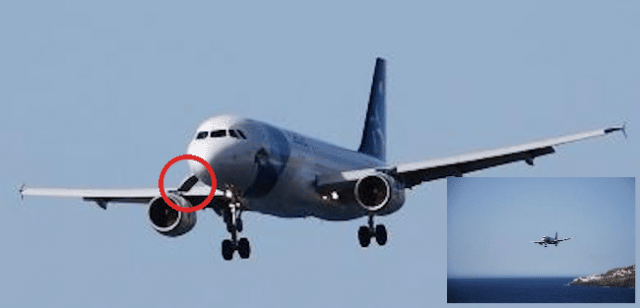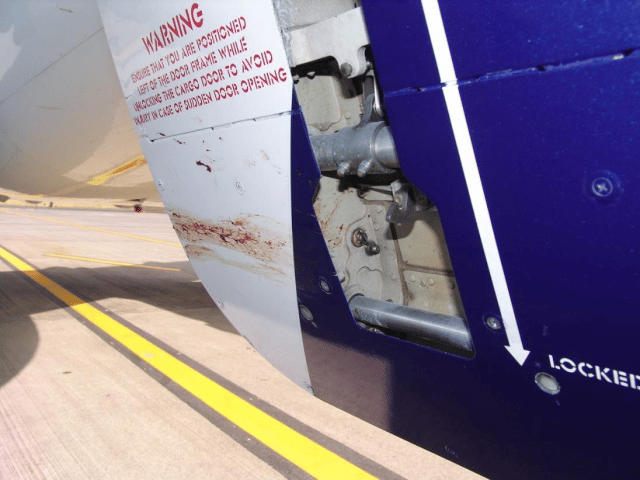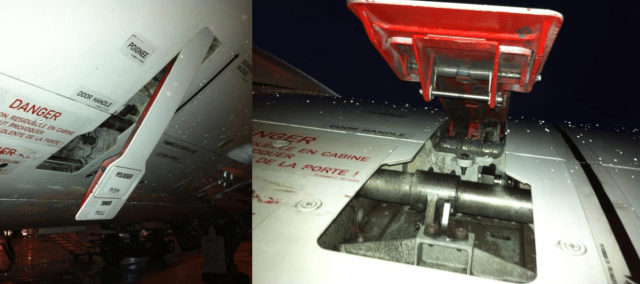Bird Opens Cargo Door on A320
On the 20th of June in 2011, an Airbus A320-212, registration CS-TKJ, taxied to runway 05 at Aeroporto de Madeira for a scheduled morning flight from Funchal to Copenhagen with seven crew members and 105 passengers on board. A plane spotter taking photographs of aircraft at the threshold of runway 05 took a photograph of the Airbus A320 as it taxied for departure.
There were three flight crew: the captain, a first officer in training and a safety pilot sitting in the jump seat. The crew was well rested; this was their first flight of the day.
The first officer, on his second flight of the training, was the Pilot Flying for the take-off from Funchal.
A large flock of seagulls had collected about two-thirds of the way down the runway, directly in the path of the accelerating A320. As the aircraft approached rotation speed, the seagulls flew into the air, colliding with the landing gear, flaps and lower surfaces of the aircraft as it became airborne.
The flight crew felt an intense vibration as some of the seagulls were sucked into the engines. Flashing alerts appeared on the Electronic Centralised Aircraft Monitor (ECAM).
As the aircraft reached 900 feet, the captain, who had taken control, pulled back on the power to try to reduce the vibrations from the engines. The aircraft lost 150 feet.
The flight crew restored full power and maintained level flight. The safety pilot took over radio communications with ATC and declared an emergency, warning the controller that they may be about to lose one or both engines.
The captain considered entering a hold and running through the checklists but with the engines still violently vibrating and the airport right there, he decided that the better course of action was to get on the ground as quickly as possible.
The flight crew requested an immediate landing. The controller confirmed that the runway was all theirs. The captain increased the power and the aircraft climbed to 1,000 feet and started right-hand circuit for runway 05. They were able to maintain 150 knots; the engines still shuddered but seemed to be operating normally.
The stress in the cockpit was high. As the right-hand circuit continued, a radio call came through to Air Traffic Control: “Cabin crews at stations, please.”
The plane spotter at the threshold took additional photographs of the A320 as it descended at 300 feet per minute.
Just over three minutes after departure, the flight crew performed a safe overweight landing on runway 05.

The A320 was decelerating along the runway when a new alert appeared n the ECAM engine/warning display: DOOR FWD CARGO. The forward cargo door symbol appeared on the display in amber.
As the aircraft taxied to the stand, the tower controller contacted the flight crew to say that the forward cargo door was open.
The photographs taken by the plane spotter showed that the forward cargo door was already open as the A320 approached the runway, although the alert did not appear until the aircraft was on the ground.

Once parked, the ground staff confirmed that the forward cargo door was swung open. The handle was set to the fully unlocked position. The door was undamaged but there was blood in the handle recess and the door and blood smeared on the door aft of the handle. All of the luggage loaded into the cargo hold was accounted for.

The engines did not have any damage on the outside, however, nine of the fan blades on engine number two and twelve of the fan blades on engine number one were damaged and covered in blood. The fan blades were replaced and no further damage was found.
The event was reported to the GPIAA and classed as a serious incident.
However, at the time, the agency did not have the resources and so they could not proceed with this and many other investigations It wasn’t until the GPIAAF (Gabinete de Prevenção e Investição de Acidentes com Aeronaves e de Acidentes Ferroviários , the Office for the Prevention and Investigation of Accidents in Civil Aviation and Rail) was established in 2017 that things began to move forward again. The GIPAAF’s first task was to rank the outstanding investigations in importance, “according to their criticality”. This accident was deemed to be “a low level of complexity” as the potential for learning something new seemed limited. As a result, the summary report was not completed until ten years after the event.

There are three cargo doors on the lower right side of the A320, labeled FWD, AFT and BULK. Both the forward and the aft cargo doors can only be opened from the outside: they have a manual locking mechanism with hydraulics that open the door outwards.
When correctly locked, a green mark shows in the access panel for every latching unit. If the door is not correctly locked, red marks show instead. In addition, the door handle will remain exposed rather than flush with the door.
The three proximity switches on the door (the handle, the frame and the latching shaft) did not send any signal that the door was not locked before take-off. This is backed up by the photographs taken by the plane spotter as the aircraft was taxiing for departure, in which the door is shut and the handle appears to be flush to the surface.
Airbus initiated an internal review and concluded that it was, as it seemed, possible for a bird striking the handle to unlock it. They ranked the event severity as “Major” as it happened at a low altitude. If the door had opened at a higher altitude and thus a higher cabin pressure, the result could have come under the heading of “Catastrophic”. However, the likelihood of encountering birds at higher altitudes is also lower and the strike against the pressurised cargo door handle would have to have been more powerful. That is, it would take a much larger bird to generate enough force to release the handle.
Airbus calculated the probability of a direct bird impact on the cargo door handle flap to be of an order of magnitude 10-09/FH. That is to say, they estimated the chances of a seagull managing to open a cargo door during flight was around once every 1,000,000,000 flight hours.
Airbus concluded that this was an isolated event and that no immediate corrective action was necessary.
Eurocopter Deutschland, who had manufactured the door, did another series of analyses as a follow-up to Airbus’ risk assessment. They concluded that the risk of this occurring in a pressurised aircraft was very low. The external force needed to move the handle would be so high that it would likely break the mechanism before unlatching the handle, thus forcing the door to remain sealed.
They also concluded that vibrations from the engine, such as those that the flight crew encountered that day, were unlikely to affect the handle position. Instead, they concluded that it was the air flow around the unpressurised aircraft that moved the handle out, which is what led to the door completely unlocking.
So the bird struck the door handle flap at exactly the right angle and managed to enter the recess which forced the handle out. Once the handle was raised against the fuselage, the air flow had something to catch on. Aerodynamic forces did the rest, unlatching the door and pushing it open.
The DOOR FWD CARGO ECAM alert is not considered in need of urgent action unless it is accompanied by a loss of pressure. Thus, the alert is inhibited during phases of flight at low altitude with a high workload, such as take-off and landing. There are 10 phases defined, as you can see from the following image, where the greyed out phases are those when the door alert would be inhibited on the ECAM.

CARGO ECAM alert inhibition logic. Amber denotes alert indication
on the ECAM during the event flight.
At 08:21 UTC the flight data recorder picked up a single ECAM warning event was recorded. This was during phase 5, the period between lift-off and reaching 1,500 feet, which corresponds with the bird strikes as they took off. The A320 never reached 1,500 feet and so the flight went straight from phase 5 to phase 7, descending on final approach. As a result, the warning was not able to be displayed until after they had touched down and had slowed to less than 80 knots on the landing roll.
Funchal serves the islands of the Madeira archipelago: Madeira, Porto Santo, the Desertas and the Savage Islands. (The runway is fun! I say that, having only been on it as a passenger and not as a pilot.) The runway tracks the coastline with an extension, added in 2000, built over the water. It is near a major harbour which has fishing activities.
Needless to say, with a location like that, the airfield has a lot of birds. There are 42 breeding species or subspecies of birds in the archipelago. The birds on the runway that day were probably Yellow-Legged Gulls, the third most abundant species at the airport. Yellow-Legged Gulls remain on the islands year-round, with a population that increases during the mating season, which is from February to July. The incident happened in June.
At the time, the airport already had a number of bird control measures in place, including:
- Bioacoustic devices attached to Follow-Me vehicles
- Propane cannons
- Live traps
- Permanent monitoring of bird species and quantities
- Guns for population control or to eliminate wildlife posing a threat to flight safety
In addition, airport personnel asked fishing boats not to pass near the shore in hopes of avoiding tempting more birds into the area.
After this incident, the airport invited the Sociedade Portuguesa para o Estudo das Aves (SPEA) to identify and document the bird life around the airport in order to recommend proposals “to diminish the attractiveness of the airport as a whole”.

AIP.
The study was completed in 2015; however most the recommendations had already been implemented. There was one exception, deliberately releasing birds of prey at the airfield.
2017 was the peak of bird strikes per aircraft movement at Funchal. That was the year that the airport introduced a falconry service, training birds of prey to hunt in the area in order to repel other birds.
In 2017, which retrospectively was the peak of bird strikes per aircraft movement at Funchal, the airport introduced a falconry service, training birds of tray to hunt in the area which would repel the other birds.
As the predator captures a bird from time to time, the deterrent is reinforced and therefore the problem of habituation is diminished, particularly if combined with other repelling measures, such as pyrotechnics.
There have not been any bird strikes involving seagulls or other large birds at the airfield since Funchal introduced the falcons.
The report concludes that although the the engines continued to give power, the captain’s decision to land immediately was the right one.
The intense vibration caused the crew concern about the imminent failure of one or both engines. As such, the crew’s decision to land immediately was the safest course of action given the circumstances, despite manoeuvring at low altitude over the sea and only becoming aware that the door was open, once they were already on the ground.
This is a slightly odd statement: even if the flight crew had been aware that the door was open, it would not have been useful information in this specific incident. It is hard to imagine making a different decision if you are aware that the cargo door has opened; in fact, the captain later said that if he’d known the door was open, he wouldn’t even have considered entering a hold to complete checklists. As it was, he turned the aircraft around and got it back onto the ground in just over three minutes.
Although this was the first known incident where an Airbus cargo door was opened by a bird strike, it happened again in 2012, just six months after the Funchal incident. An A319 was on final approach to Algiers when they heard a thud at about 100 feet above the runway. They landed safely but as they decelerated on the runway, the ECAM showed a DOOR FWD CARGO alert. Ground staff found the handle out of the recess and unlocked, with blood inside the handle and streaked behind it. The cargo door was still closed and latched, presumably as it landed so soon after the strike.

found upon arrival in Algiers.
In response to the two incidents, Airbus has designed a new handle with a push-button to act as a safety to prevent a bird strike from unlatching the door. This new handle has been available since February 2016 (Service Bulletin A320-52-1774).
Only one open issue remains. Currently, if the flight crew experience of an A320 an DOOR FWD CARGO ECAM alert, they do not have to take any action as long as the cabin pressure remains normal.
However, it is now clear that if the door is unlocked, triggering the alert, the aerodynamics could cause the door to open during the flight and the flight crew would not receive any further notification. Once open, the door could separate from the aircraft and cause damage to other parts of the aircraft.
As a result, the report recommends that Airbus develop a crew alert and procedure for the door opening during flight (unlocked and unlatched) so that the crew is aware if the door has fully opened.
The full report in PDF format is available for download on the GPIAAF website. Thank you to José for drawing my attention to it.








I must say that in all my life I have never heard of a “bird of tray” ;-)
On another more serious note: I have encountered a flock of geese at FL 230. Obviously these birds can cruise at altitudes where structural damage caused by the impact of a bird strike can be very serious. Geese are large birds. Actually, at the Christmas dinner they may end up on a tray – in the oven! But once they are “birds of tray” it is unlikely that they will be found at an altitude above the height of the dinner table!
Joking aside, it seems that the crew did a good job. I quite agree with the captain’s decision to land immediately, rather than delaying the landing by going through lengthy emergency check lists that probably would not have given much information related to the emergency.
Safely back on “terra firma” there was enough time to go over the cause and hand it over to the experts to analyse the problem. Yes, a job well done.
Oh no! I must have been excessively hungry when I wrote that bit!
I was looking for this information as soon as I learned this was an airbus and that there had been no alert during flight, thank you! Harking back to last week, this is a deliberate interface design choice to avoid overloading pilots with irrelevant information—thank you for going the extra mile (or km?) to report that the pilot agreed with this choice.
This could’ve been quite the Sullenberger situation, thankfully the engines didn’t fail!
The Citation 500 series have a baggage locker in the nose. It is closed by two latches on both sides. The lockers are not pressurized and I have never had one open in flight.
I believe that it has happened, but apart from buffeting, insofar as I am aware, there were no serious consequences. Although, if luggage were to come out during a flight it probably could have ended being sucked in an engine.
Very interesting. Has anyone calculated how many flight hours have eplapsed up to the present day? “That is to say, they estimated the chances of a seagull managing to open a cargo door during flight was around once every 1,000,000,000 flight hours.” I’m wondering if we can check the statistics. And, “Once the handle was raised against the fuselage, the air flow had something to catch on. Aerodynamic forces did the rest, unlatching the door and pushing it open.” Has anyone discussed re-designing these types of handles so aerodynamic forces tend to push the lever closed instead of open it?
Great story, thanks Sylvia.
Mike
As of March 2022, the A320 fleet had 286+ million flight hours globally, per https://www.airbus.com/sites/g/files/jlcbta136/files/2022-04/Airbus-A320-Family-Facts-and-Figures-April-2022.pdf . Given that a bird has managed to open that cargo door on two occasions, the true likelihood is probably closer to 1 in every 100,000,000 flight hours, with the old handle design.
I believe the aerodynamic forces push unlatched cargo doors open by necessity, since the static pressure inside the hold is more than the dynamic pressure on the outside of the door.
Hats off to a cool headed Pilot. I have been to Funchal 1/2 a dozen times. It is high on my list of least favorite airports.
After liftoff, there is nowhere to go other than out to sea, there is this big mountain thing on the other side. The only close by alternative is Madeira probably over 100Km away and it is on the other side of that mountain.
Someone in the cockpit felt (understandably!) quite stressed:
Still, that was good decision-making and good flying!